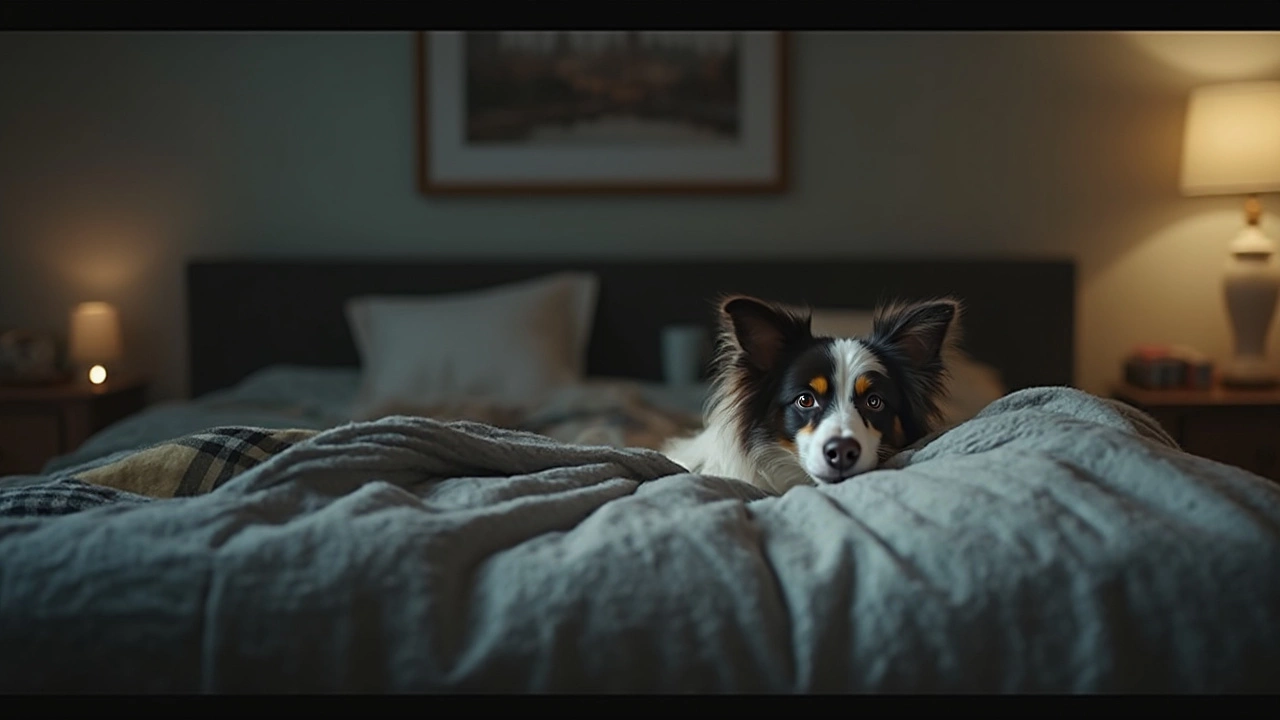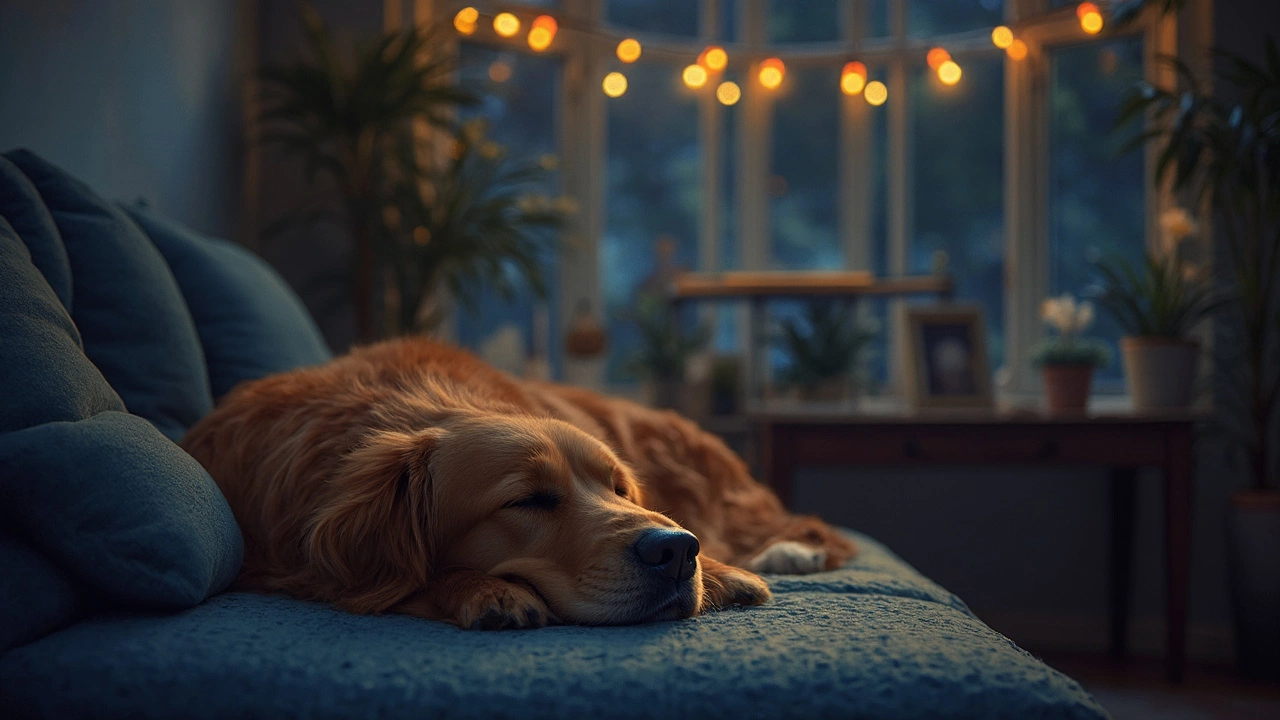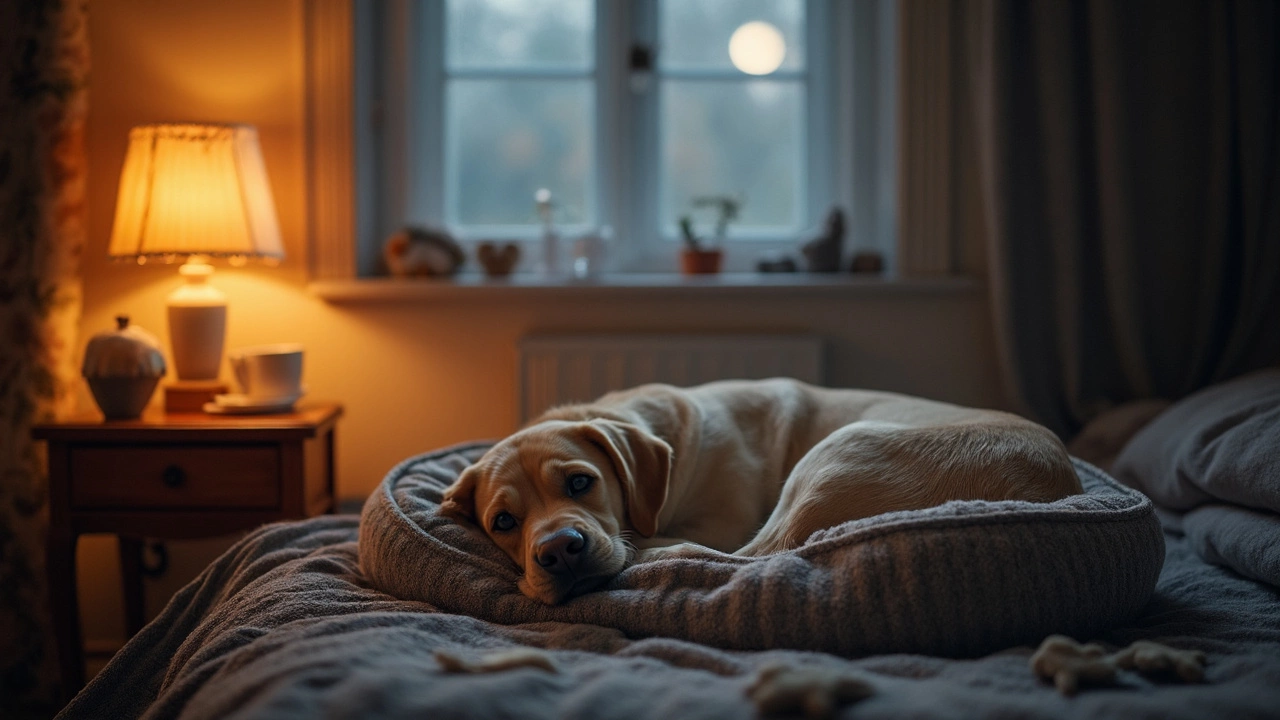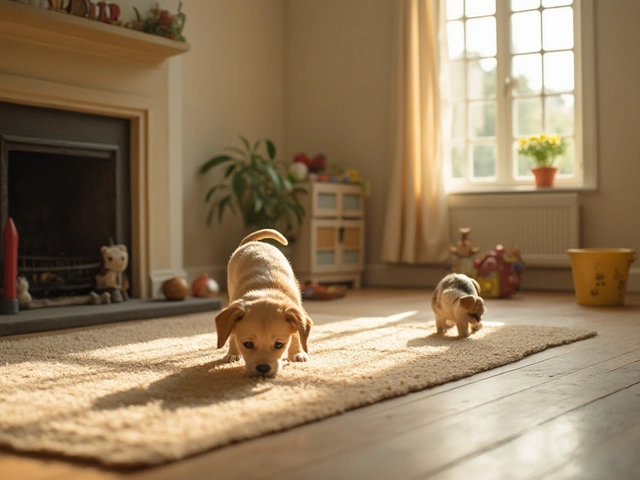Ever wondered if your dog needs the light on at night, or if they'd rather snooze in the dark? You're definitely not alone. Pet owners ask about this all the time, especially when it comes to picking the right spot or setup for their dog's bed.
Here's the thing—dogs' eyes work differently than ours when it comes to darkness. Dogs have more rods in their eyes, which means they see better than we do in low light. That's why your dog can move around at night without bumping into stuff. But that doesn't mean every dog loves total darkness.
Dogs pick up on our routines. If your house usually dims down at night and your dog's bed is in your room, chances are they're fine sleeping in the dark right next to you. Still, some pups get anxious or even scared if it's pitch black, especially if they're new to the home or a bit more on the nervous side. I've seen dogs settle down just by adding a small night light near their bed—nothing fancy, just enough to take away the pitch-black feeling.
- How Dogs See in the Dark
- The Impact of Light on Dog Sleep
- Signs Your Dog Needs a Night Light
- Choosing the Best Light Setup
- Tips for the Coziest Dog Bed Environment
How Dogs See in the Dark
It might feel like magic, but dogs can see way better in the dark than we can. Their eyes are built for it. Ever notice your pup moving around at night without knocking into things? That’s because their eyes have a lot more light-sensitive cells (called rods) than ours do. Rods help them pick up shapes and motion in low light, which gives dogs a big advantage after sunset.
Here’s something wild—dogs also have a special layer in their eyes called the tapetum lucidum. This acts like a built-in mirror, bouncing light back through the retina so they get a second shot at seeing whatever’s out there. That’s why your dog’s eyes sometimes glow in photos taken at night. This feature helps them spot movement or objects when it’s pretty dark, way beyond what humans can do.
Still, dogs can’t see in complete darkness any better than we can. No light means no vision, even for pets. But in dim settings, like when you have just a little hallway light on, dogs usually have all they need.
Quick rundown of what helps dogs see in the dark:
- More rods in the retina for grabbing faint light
- The tapetum lucidum for reflecting light inside the eye
- Large pupils that open wide to let more light in
All this means that your dog probably doesn’t need the room lit up like daytime just to get comfy on their dog beds. If there’s a tiny bit of light from another room or a streetlamp, most dogs will be just fine navigating their territory.
The Impact of Light on Dog Sleep
Let’s get real: the light in your dog’s sleeping space actually plays a bigger role than most people think. Dogs are wired a lot like us when it comes to sleeping and waking cycles, or what the experts call the circadian rhythm. If there’s a bunch of light around their bed all night, it can throw off their natural groove—even if they’re not as picky about a totally dark room as most humans.
Dogs need melatonin to help them get deep, restful sleep. Melatonin is a hormone the body makes when it starts to get dark. When you keep the lights on all night, it messes with melatonin production, and that can leave your dog feeling restless or grumpy in the morning. Dr. Jerry Klein, Chief Veterinary Officer at the American Kennel Club, sums it up like this:
"Like humans, dogs benefit from a regular sleep routine and an environment that matches their natural sleep patterns. Too much light during their usual rest time can interfere with their sleep quality."
Too much brightness might even lead to more barking or whining at night, especially in young dogs or new rescues. On the other hand, some pups who experience anxiety or have sight problems may appreciate a dim night light by their dog bed.
- Blue or white LED lights are the worst offenders—they’re more likely to interrupt your pup’s sleep cycle compared to warm, soft lighting.
- If your dog’s bed sits near a window with a streetlight right outside, try blackout curtains. These can make the spot feel more secure and cozy.
- Don’t go overboard with total darkness if your dog seems unsettled—it’s fine to experiment with a low night light and see if things improve.
Some useful numbers to keep in mind:
| Lighting Level (lux) | Effect on Dog Sleep |
|---|---|
| 0-5 lux | Promotes natural, healthy sleep |
| 10-30 lux | Mildly disturbing for some dogs |
| 50+ lux | Significantly disrupts melatonin and may lead to restlessness |
The bottom line? Aim for dark or dim, and notice if your dog snoozes better or seems more chilled out in the morning. If you spot pacing, whining, or lots of moving around, lighting might be worth tweaking.

Signs Your Dog Needs a Night Light
So how do you know if your dog actually wants a light on at night? It’s not like they can just ask you. But dogs have a way of showing us when something's up, and if you pay attention to their habits around bedtime, you’ll see some clear signs.
- Your dog whines, barks, or paces after the lights go out. This often means they're anxious or looking for reassurance.
- They have accidents at night, even if they're usually house-trained. Some dogs get nervous in the dark and won’t move off their dog beds to go to their potty area.
- You notice them bumping into furniture if they get up at night—especially older dogs who might be losing a bit of vision.
- Restless sleep—your pup is moving around a lot, waking up, or scratching at the door instead of snoozing peacefully.
- Your dog sticks close to you at night but seems fine in the daytime. Some want to sleep right against you if they can’t see well in the dark.
Here’s a quick table that shows certain behaviors and what they might mean about your dog's comfort level at night:
| Behavior | Possible Reason |
|---|---|
| Whining or pacing at night | Nighttime anxiety or fear of the dark |
| Frequent accidents away from usual spot | Reluctance to move in the dark |
| Bumping into things at night | Vision trouble or too little light |
| Restless sleep | Unsettled due to unfamiliar surroundings or darkness |
Every dog is a little different. Puppies and seniors are more likely to have trouble with dark rooms. A lot of older dogs develop issues like cataracts that make it harder for them to see at night. If your pup came from a shelter, they might also be more anxious about new spaces, especially if they’ve had some rough experiences in the past.
"Dogs rely on their environment for cues. A little night light can comfort older dogs or pups with anxiety, making sleep time much smoother." — Dr. Karen Becker, integrative veterinarian
If you spot any of these behaviors, trying out a small, low-light night lamp near your dog's sleeping area could make a huge difference. No need for anything fancy—just enough glow to help them move around, feel safe, and get a good night's rest.
Choosing the Best Light Setup
Picking the right lighting for your dog's sleeping area isn’t about style—it's about comfort and sleep quality. The best setup depends on your dog’s habits, age, and whether they show signs of night anxiety.
If you have a puppy or an older dog, a small night light can do wonders. Puppies often feel safer with a little glow in the room, especially if they’ve never slept alone. Senior dogs, on the other hand, can develop vision issues like cataracts or night blindness, so a soft light helps them find their dog beds without tripping or getting confused.
For most adult dogs who are comfortable in your home, total darkness or a bit of hallway light is usually just fine. If your pup gets up at night or seems restless, a plug-in LED night light near their bed or in the hallway might help. Look for something with a warm, low lumen (brightness) rating—nothing too bright. Lights from lamps or phones can be way too harsh and might even mess with your dog's natural sleep cycle.
- Avoid blue or cool-toned LED lights because these can disrupt your dog’s sleep pattern. Go for red, orange, or soft white colors for less interference.
- Make sure the light isn’t shining right into your dog’s bed or eyes.
- Test different setups: some dogs like pitch darkness, while others sleep better with a glow. A cheap, low-watt night light usually does the trick.
- If your dog sleeps in a crate, position the light outside the crate and not inside, to avoid glare or overheating.
Here’s a quick comparison of common light setups and their features:
| Light Type | Brightness (Lumens) | Best For | Notes |
|---|---|---|---|
| Night Light (LED) | 5-20 | Puppies, seniors, anxious dogs | Soft glow, energy efficient, minimal heat |
| Hallway Light | 40-60 | Most healthy adult dogs | Not direct, just enough to see surroundings |
| Room Lamp | >150 | Not recommended for sleep | Too bright, can disrupt natural cycles |
| No Light | 0 | Confident sleepers, dogs used to dark | Best for dogs with no anxiety issues |
Bottom line: There’s no one-size-fits-all answer. Watch your dog’s body language and try out different lighting options for a few nights. You’ll quickly see what helps your pup settle down for the night.

Tips for the Coziest Dog Bed Environment
Getting your dog's bed just right is a game-changer for their comfort and sleep quality. Start by choosing a bed that matches your dog's size and sleep style. Some pups sprawl out, while others curl up tight—make sure the bed gives them enough room and support, especially if your dog has arthritis or is a senior.
Placement of the bed matters more than you'd think. Put the bed in a low-traffic spot, away from cold drafts or direct heat sources like radiators. Dogs love feeling safe and having their own little hub. If your home gets chilly, a raised dog bed or adding a cozy blanket can keep them warmer at night.
Lighting is huge for dog comfort, especially for new rescues or anxious pups. A small night light can ease nerves, but avoid harsh overhead lights or flashing electronics nearby. Think dim, gentle lighting, just enough to cut the darkness without disrupting sleep.
Most dogs want a clean bed. Weekly washes of the outer cover (or more, if they track in mud) can cut down on smells, pests, and allergens. If your dog has allergies or sensitive skin, look for hypoallergenic bedding and skip heavy scents or detergents.
- Pick the right dog bed size and thickness for your dog's breed and age.
- Keep water close by, but not so close that it spills onto the bed.
- Add a favorite toy or comfort object—this can make the bed feel way more inviting.
- Watch for signs your dog’s not comfy: excessive scratching, moving around, or avoiding the bed are clues to tweak something.
Here's a quick comparison of common dog bed types and when they're best used:
| Bed Type | Best For | Notes |
|---|---|---|
| Orthopedic Foam | Senior dogs, joint problems | Extra support and often washable |
| Bolster Beds | Dogs who like resting their head | Feels safe, especially for anxious pups |
| Cooling Gel Beds | Hot climates, thick-coated breeds | Helps prevent overheating |
| Raised Cot Beds | Outdoor use, air flow | Keeps dogs off cold floors, easy to clean |
Pay attention to your dog's habits. Some dogs love being near you, while others want their own corner. Tweak things based on what you see, and don’t be afraid to experiment. The right setup improves sleep—for both of you.





